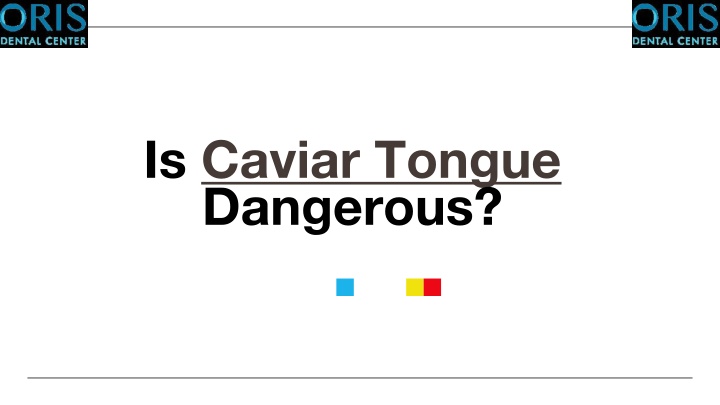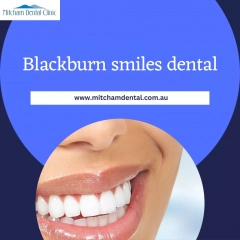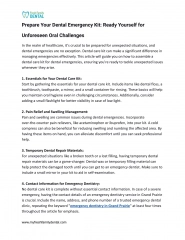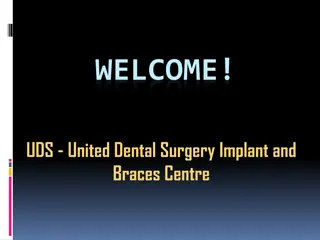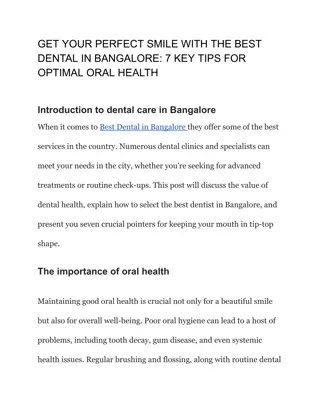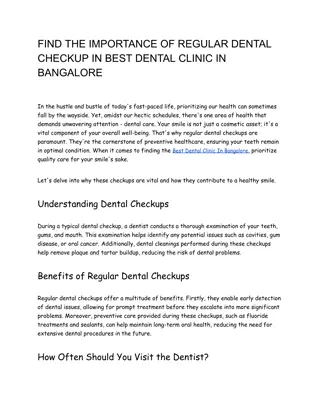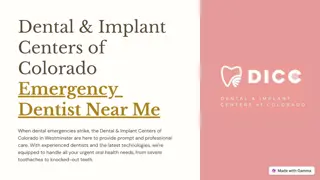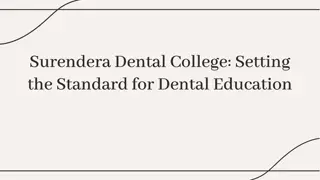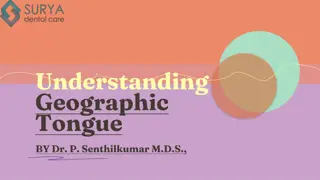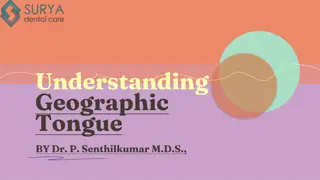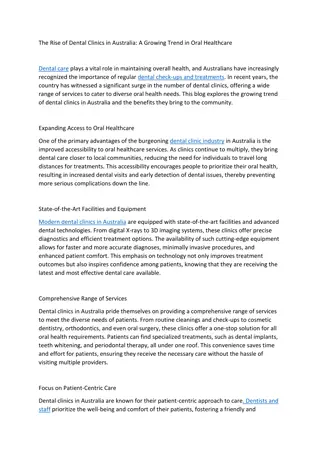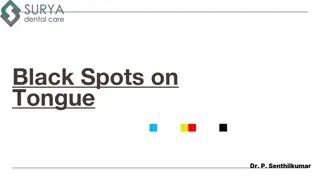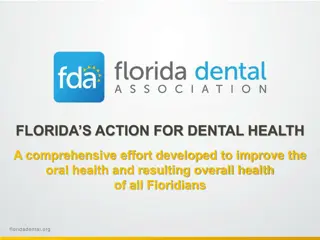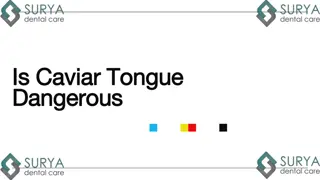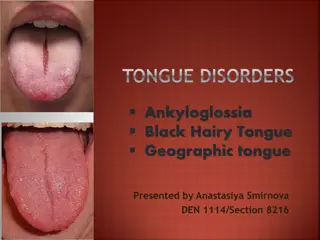Caviar Tongue - Oris Dental Center
Caviar tongue is an unharmful physiological change that is caused due to aging. Read more about the causes, symptoms, and treatments in the blog post. For more info visit: // /blog/is-caviar-tongue-dangerous/
Download Presentation

Please find below an Image/Link to download the presentation.
The content on the website is provided AS IS for your information and personal use only. It may not be sold, licensed, or shared on other websites without obtaining consent from the author.If you encounter any issues during the download, it is possible that the publisher has removed the file from their server.
You are allowed to download the files provided on this website for personal or commercial use, subject to the condition that they are used lawfully. All files are the property of their respective owners.
The content on the website is provided AS IS for your information and personal use only. It may not be sold, licensed, or shared on other websites without obtaining consent from the author.
E N D
Presentation Transcript
Is Caviar Tongue Dangerous? Caviar Tongue
AGENDA What Is Caviar Tongue? Where Does Caviar Tongue Occur? Main Causes of Caviar Tongue Symptoms and Signs Is Caviar Tongue Dangerous? Treatment and Management Options When to See a Doctor or Dentist Key Takeaways and FAQs
What Is Caviar Tongue? Definition Visual Characteristics Other Names Caviar tongue is a medical term for The veins appear swollen and dark This condition is also known as a physiological change where the purplish, resembling small black sublingual varicosities or sublingual veins under the tongue become pearls or caviar, which gives the varices, indicating varicose veins enlarged, twisted, and dark purple in condition its name. located beneath the tongue. color.
Where Does Caviar Tongue Occur? Typical Location and Appearance Caviar tongue occurs along the sublingual veins on the underside of the tongue, running parallel on each side. Normal sublingual veins are thin, blue, and barely visible beneath the tongue's surface. In caviar tongue, these veins become enlarged, swollen, dark purplish, and twisted, resembling small black pearls. This makes the veins prominently visible and distinguishable from normal veins during oral examination.
Main Causes of Caviar Tongue Aging and Senile Elastotic Degeneration With age, the connective tissue and muscle fibers in sublingual veins lose elasticity and weaken, causing veins to enlarge and twist, a process called senile elastotic degeneration. Increased Venous Pressure Factors like straining, prolonged standing, or high blood pressure raise venous pressure, contributing to the dilation and swelling of veins under the tongue. Genetic Predisposition Inherited vein structure and strength can make some individuals more susceptible to developing sublingual varices, including caviar tongue. Other Rare Health Conditions Certain systemic conditions affecting blood flow or increasing venous pressure, such as portal hypertension, may occasionally contribute, but these are uncommon causes.
Symptoms and Signs Lack of Pain or Discomfort Most individuals with caviar tongue experience no pain, discomfort, or functional issues, making it often an incidental finding during oral examinations. Occasional Sensations Some might feel a mild sensation of fullness or awareness under the tongue, or slight tenderness if the area is pressed or accidentally traumatized. Cosmetic Concerns The prominent, dark purplish veins can cause aesthetic worries for some individuals, though these concerns are purely visual and not medically harmful.
Is Caviar Tongue Dangerous? Harmless Nature of Caviar Tongue Caviar tongue is a physiological change, not a disease or infection. It does not cause pain, discomfort, or functional problems. The condition develops slowly and is associated mainly with aging. There is no risk of spreading caviar tongue to others through contact. Addressing Common Myths and Concerns Caviar tongue is not caused by eating caviar or any specific foods. It is not contagious and cannot be transmitted by kissing or sharing food. Caviar tongue does not lead to serious health complications or cancer. Most cases do not require any medical treatment or intervention.
Treatment and Management Options Reassuran ce & Education Manage Health Issues Surgery or Laser Observatio n Most cases of caviar tongue do not require active treatment. Regular monitoring by a dentist during routine check-ups is sufficient to ensure no complications develop. Patients are informed that caviar tongue is harmless, non-contagious, and does not lead to serious health problems. This reduces anxiety about its appearance. Managing systemic conditions that increase venous pressure, such as hypertension, helps prevent progression. Lifestyle modifications may be recommended to reduce strain on veins. In uncommon cases with significant vein enlargement, discomfort, or bleeding, minor surgical removal or laser ablation may be performed by a specialist. Specialist referral Surgical vein removal Laser therapy sessions Patient education materials Counseling sessions Clear communication about condition Regular dental check-ups Monitoring vein appearance Documentation of changes Health assessment Blood pressure control Lifestyle advice and interventions
When to See a Doctor or Dentist Sudden Swelling or Enlargement Persistent Pain or Discomfort If you notice a rapid increase in size or swelling of the veins or tissues under your tongue, it is important to consult a healthcare professional promptly. Ongoing pain or tenderness under the tongue that does not improve should be evaluated to rule out infections or other conditions. Unexplained Bleeding or Trauma Suspicious Lumps or Lesions Bleeding from the veins under the tongue without clear cause or repeated trauma requires medical attention to prevent complications. Any unusual lumps, bumps, or lesions in the mouth or under the tongue should be examined by a dentist to exclude serious conditions.
Key Takeaways and FAQs Caviar Tongue Safety Management Overview Symptoms of Diseased Tongue Caviar tongue is a benign, non-contagious condition caused by aging-related changes in the veins under the tongue. It does not lead to serious health problems or require treatment in most cases. Most cases need only observation and reassurance. Treatment is rare and only necessary for cosmetic reasons or complications like bleeding or discomfort. Diseased tongues may show persistent pain, ulcers, color changes, swelling, or difficulty moving. Such symptoms warrant medical evaluation to rule out serious conditions. What is Furry Tongue? Dark Veins Under Tongue Tongue Ridges Explanation Furry tongue is caused by keratin buildup on the tongue surface, often linked to poor oral hygiene, smoking, or dry mouth. It s harmless and improves with proper cleaning. Ridges or scalloped edges on the tongue often result from pressure, dehydration, or mild inflammation and are usually harmless but can indicate issues like teeth grinding. Dark veins visible under the tongue are normal sublingual veins that become prominent with age, known as caviar tongue. This is a natural, harmless physiological change.
Follow Us and Book an Appointment Follow Us on Social Media Book an Appointment Book an Appointment Visit our website to book online. Website: https://www.orisdentalcenter.ae https://www.orisdentalcenter.ae Call us at our Jumeirah, Alkhwaneej, Mirdif, or Nad Al Sheba branches. LinkedIn: https://www.linkedin.com/company/oris-dental-center-dubai/ https://www.linkedin.com/company/oris-dental-center-dubai/ Facebook: https://www.facebook.com/orisdentaldubai https://www.facebook.com/orisdentaldubai Instagram: https://www.instagram.com/orisdentalcenter/ https://www.instagram.com/orisdentalcenter/
